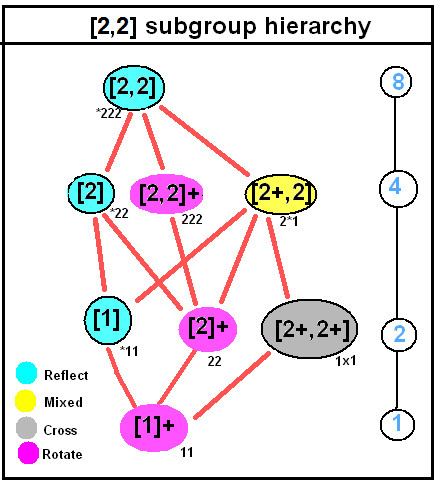 | ||
In geometry, dihedral symmetry in three dimensions is one of three infinite sequences of point groups in three dimensions which have a symmetry group that as abstract group is a dihedral group Dihn ( n ≥ 2 ).
Contents
Types
There are 3 types of dihedral symmetry in three dimensions, each shown below in 3 notation: Schönflies notation, Coxeter notation, and orbifold notation.
For a given n, all three have n-fold rotational symmetry about one axis (rotation by an angle of 360°/n does not change the object), and 2-fold about a perpendicular axis, hence about n of those. For n = ∞ they correspond to three frieze groups. Schönflies notation is used, with Coxeter notation in brackets, and orbifold notation in parentheses. The term horizontal (h) is used with respect to a vertical axis of rotation.
In 2D the symmetry group Dn includes reflections in lines. When the 2D plane is embedded horizontally in a 3D space, such a reflection can either be viewed as the restriction to that plane of a reflection in a vertical plane, or as the restriction to the plane of a rotation about the reflection line, by 180°. In 3D the two operations are distinguished: the group Dn contains rotations only, not reflections. The other group is pyramidal symmetry Cnv of the same order.
With reflection symmetry with respect to a plane perpendicular to the n-fold rotation axis we have Dnh [n], (*22n).
Dnd (or Dnv), [2n,2+], (2*n) has vertical mirror planes between the horizontal rotation axes, not through them. As a result the vertical axis is a 2n-fold rotoreflection axis.
Dnh is the symmetry group for a regular n-sided prisms and also for a regular n-sided bipyramid. Dnd is the symmetry group for a regular n-sided antiprism, and also for a regular n-sided trapezohedron. Dn is the symmetry group of a partially rotated prism.
n = 1 is not included because the three symmetries are equal to other ones:
For n = 2 there is not one main axes and two additional axes, but there are three equivalent ones.
Subgroups
For Dnh, [n,2], (*22n), order 4n
For Dnd, [2n,2+], (2*n), order 4n
Dnd is also subgroup of D2nh.
Examples
Dnh, [n], (*22n):
D5h, [5], (*225):
D4d, [8,2+], (2*4):
D5d, [10,2+], (2*5):
D17d, [34,2+], (2*17):
